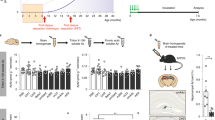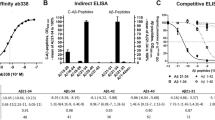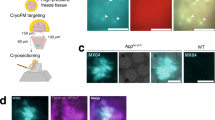Abstract
Alzheimer's disease1 is characterized by a widespread functional disturbance of the human brain. Fibrillar amyloid proteins are deposited inside neurons as neurofibrillary tangles2 and extracel-lularly as amyloid plaque cores2 and in blood vessels2. The major protein subunit (A4) of the amyloid fibril of tangles, plaques and blood vessel deposits is an insoluble, highly aggregating small polypeptide of relative molecular mass 4,5003–6. The same polypep-tide is also deposited in the brains of aged individuals with trisomy 21 (Down's syndrome)3,5,6. We have argued previously that the A4 protein is of neuronal origin and is the cleavage product of a larger precursor protein4,6. To identify this precursor, we have now isolated and sequenced an apparently full-length complementary DNA clone coding for the A4 polypeptide. The predicted precursor consists of 695 residues and contains features characteristic of glycosylated cell-surface receptors. This sequence, together with the localization of its gene on chromosome 21, suggests that the cerebral amyloid deposited in Alzheimer's disease and aged Down's syndrome is caused by aberrant catabolism of a cell-surface receptor.
This is a preview of subscription content, access via your institution
Access options
Subscribe to this journal
Receive 51 print issues and online access
$199.00 per year
only $3.90 per issue
Buy this article
- Purchase on Springer Link
- Instant access to full article PDF
Prices may be subject to local taxes which are calculated during checkout
Similar content being viewed by others
References
Alzheimer, A. Allg. Z. Psychiat. 64, 146–148 (1907).
Katzman, R. (ed.) Biological Aspects of Alzheimer's Disease (Banbury Report 15) (Cold Spring Harbor Laboratory, New York, 1983).
Masters, C. L. et al. Proc. natn. Acad. Sci. U.S.A. 82, 4245–4249 (1985).
Masters, C. L. et al. EMBO J. 4, 2757–2763 (1985).
Glenner, G. G. & Wong, C. W. Biochem. biophys. Res. Commun. 120, 1131–1135 (1984).
Beyreuther, K. et al. in Discussions in Neuroscience Vol. 3 (eds Bignami, A., Bolis, L. & Gajdusek, D. C. 68–79 Fondation pour I'Étude du Système Nerveux, Geneva (1986).
Okayama, H. & Berg, P. Molec. cell. Biol. 3, 280–289 (1983).
Blobel, G. & Dobberstein, B. J. Cell Biol. 67, 852–862 (1975).
Yarden, Y. et al. Nature 323, 226–232 (1986).
Geisler, N., Plessmann, U. & Weber, K. FEBS Lett. 182, 475–478 (1985).
Lewis, S. A. & Cowman, N. J. Molec. cell. Biol 6, 1529–1534 (1986).
Oesch, B. et al. Cell 40, 735–746 (1985).
Thomas, P. S. Proc. natn. Acad. Sci. U.S.A. 77, 5201–5205 (1980).
Southern, E. M. J. molec. Biol 98, 503–517 (1975).
Lötscher, E. et al. Nature 320, 456–458 (1986).
Gajdusek, D. C. Science 197, 943–960 (1977).
Multhaup, G. et al. EMBO J. 4, 1495–1501 (1985).
Merz, P. A., Sommerville, R. A., Wisniewski, H. M. & Iqbal, K. Acta neuropath. 54, 63–74 (1981).
Diringer, H. et al. Nature 306, 476–478 (1983).
Prusiner, S. B. et al. Cell 35, 349–358 (1983).
Liao, Y-C. J., Lebo, R. V., Clawson, G. A. & Smuckler, E. A. Science 233, 364–367 (1986).
Goldgaber, D., Lerman, M. I., McBride, W. O., Sallow, V. & Gajdusek, D. C. Science (in the press).
Robakis, N. K. et al. Lancet (manuscript in preparation).
Bernstein, S. L., Gioco, A. E. & Kaplan, B. B. J. Neurogenet. 1, 71–86 (1983).
Aviv, H. & Leder, P. Proc. natn. Acad. Sci. U.S.A. 69, 1408–1412 (1972).
Woods, D. E., Markham, A. F., Ricker, A. T., Goldberger, G. & Colten, H. R. Proc. natn. Acad. Sci. U.S.A. 79, 5661–5665 (1982).
Sanger, F., Nicklen, S. & Coulson, A. R. Proc. natn. Acad. Sci. U.S.A. 74, 5463–5467 (1977).
Matteucci, M. D. & Caruthers, M. H. J. Am. Chem. Soc. 103, 3185–3190 (1981).
Hewick, R. M., Hunkapiller, M. W., Hood, L. E. & Dreyer, W. J. J. biol. Chem. 256, 7990–7997 (1981).
Lehrach, H., Diamond, D., Wozney, J. M. & Boedtker, H. Biochemistry 16, 4743–4751 (1977).
Rigby, P. W. J., Dieckmann, M., Rhodes, C. & Berg, P. J. molec. Biol. 113, 237–251 (1977).
Author information
Authors and Affiliations
Rights and permissions
About this article
Cite this article
Kang, J., Lemaire, HG., Unterbeck, A. et al. The precursor of Alzheimer's disease amyloid A4 protein resembles a cell-surface receptor. Nature 325, 733–736 (1987). https://doi.org/10.1038/325733a0
Received:
Accepted:
Issue Date:
DOI: https://doi.org/10.1038/325733a0
This article is cited by
-
miR-277 targets the proapoptotic gene-hid to ameliorate Aβ42-mediated neurodegeneration in Alzheimer’s model
Cell Death & Disease (2024)
-
Neuropathogenesis-on-chips for neurodegenerative diseases
Nature Communications (2024)
-
Clinical trials of new drugs for Alzheimer disease: a 2020–2023 update
Journal of Biomedical Science (2023)
-
APP family member dimeric complexes are formed predominantly in synaptic compartments
Cell & Bioscience (2023)
-
Early events in amyloid-β self-assembly probed by time-resolved solid state NMR and light scattering
Nature Communications (2023)
Comments
By submitting a comment you agree to abide by our Terms and Community Guidelines. If you find something abusive or that does not comply with our terms or guidelines please flag it as inappropriate.



